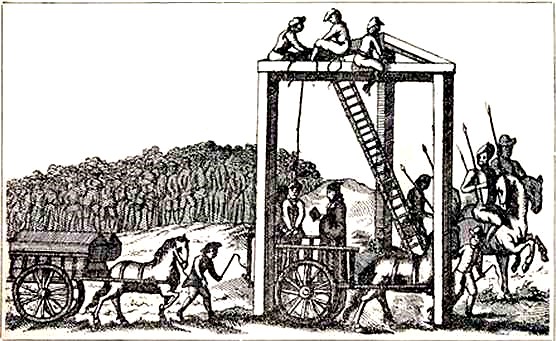 The gallows at Tyburn in London were the site of the demise of many infamous characters. The first record of an execution there dates from 1196 when the leader of the London tax riots, William Fitz Osbern, along with nine of his accomplices were hanged from a gibbet. In 1499, Perkin Walbeck was convicted of treason and hanged at Tyburn: he had led the Cornish Rebellion two years before, claiming to be Richard IV, the younger of the two princes imprisoned in the Tower of London by their uncle, King Richard III.
The gallows at Tyburn in London were the site of the demise of many infamous characters. The first record of an execution there dates from 1196 when the leader of the London tax riots, William Fitz Osbern, along with nine of his accomplices were hanged from a gibbet. In 1499, Perkin Walbeck was convicted of treason and hanged at Tyburn: he had led the Cornish Rebellion two years before, claiming to be Richard IV, the younger of the two princes imprisoned in the Tower of London by their uncle, King Richard III.In 1571 the Elizabethan authorities constructed the "Tyburn Tree" a horizontal wooden triangle on three legs that enabled many people to be hanged at the same time. The religious strife of that period meant that many people were martyred at Tyburn including Edmund Campion, Robert Southwell and John Southworth, all of whom were later made saints by the Roman Catholic church. Later, following the restoration of King Charles II to the throne, the bodies of the regicides John Bradshaw, Oliver Cromwell, and Henry Ireton were exhumed and symbolically hanged in an act of grisly revenge.
On 3rd November 1783, the highwayman John Austin became the last person to be hanged at Tyburn. He was convicted of robbing and wounding 'a poor man' called John Spicer in a field near the road in Bethnal Green. Reportedly Austin's last words were "Good people, I request your prayers for the salvation of my departing soul; let my example teach you to shun the bad ways I have followed; keep good company, and mind the word of God." The sight of the "Tyburn Tree" is marked today by three brass triangles where Bayswater Road meets Edgware Road.
The transcript of the trial of John Austin is available on the Proceedings of the Old Bailey web-site.
Related posts
Sir Walter Raleigh beheaded: 29th October 1618
First execution in Salem witch trials: 10th June 1692
Guillotine used for first time: 25th April 1792
Louis XVI executed: 21st July 1793
Prince Murat executed: 13th October 1815
Rosenbergs executed: 19th June 1953

No comments:
Post a Comment